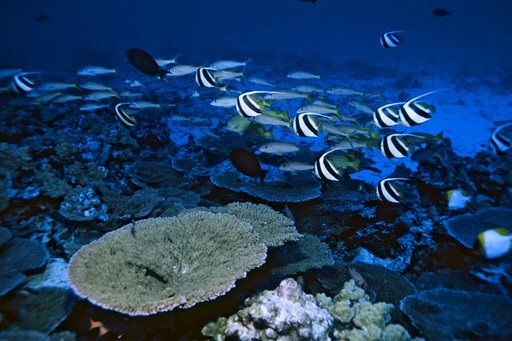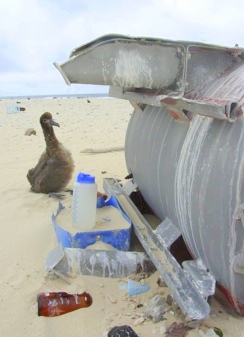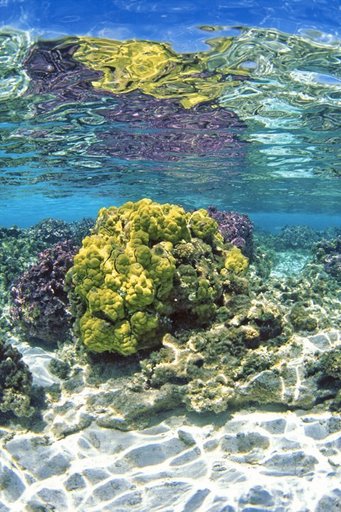Blog
News, updates, finds, stories, and tidbits from staff and community members at KAHEA. Got something to share? Email us at: kahea-alliance@hawaii.rr.com.
Where's the public in this "public process"?
From Evan, law school student and Legal Fellow from the Center for Excellence in Native Hawaiian Law working on staff with KAHEA this summer:
Was thrown into the deep waters of the 1,200 page Papahanaumokuakea Draft Monument Management Plan for the Northwestern Hawaiian Islands this summer. It’s given me a unique opportunity to observe the workings of this “public” process. I’ve worked with experts in reviewing the plan, and attended several of the public hearings set up by the State/Federal Co-Trustee agencies. My observation: It is a recipe for disaster to take two years of closed door processes, package it into 4 very thick volumes and then expect the public at large to comment in any detail about what the plan entails. 
(This is what 700 pages of the 1,200 page plan looks like. Erm, fun.)
I first attended the hearing at the Department of the Interior in Washington D.C. (the only hearing held outside our lovely archipelago). I was quickly made aware of the fact that I would be the only person offering public testimony. So much for the public in this public hearing.
After giving an impassioned 20 minute explanation of KAHEAʻs overarching concerns, I was flooded with a steady stream of “How do you do’s?” and “Can we get a copy of your testimony?” from interested national NGO’s and congressional staffers. I was glad for the opportunity to get the word out on our key concerns, despite the dismal showing of public engagement.
The next chance I had to attend was the final night of the Federal/State Co-Trustee Island Summer Hearings Tour 2008. From all accounts, the crowd of about 60 at the Japanese Cultural Center in Moilili was by far the largest of any of the meetings. The format was a little different from D.C. and to be honest, quite unlike anything I had ever witnessed before. After a formal introduction to the Monument (same as D.C.), was an open discussion with Monument staff who were broken into 6 tables that synchronized with 6 priority management needs from the plan. It had an element of “spoon-feeding” to it, and considering that many had come to supply public testimony, made things run a little later than they may have otherwise. Nonetheless, I found this segue to be a nice opportunity to bring some of my major gripes with the plan directly to the folks who had put it together.
Over the course of this experience, I have been amazed at the bizarre nature of this top-down “public” process.
When asked: “Why was the citizen’s advisory council removed from the plan?”
A rep responded: “Actually, we do want one. We left it out because we wanted to see what the public would come up with during the review period.”
I’d suggest that a proper, engaged public process wouldn’t have waited until the review period to see what the “the public would come up with.” It all reminded me of the hide the ball game my law professors sometimes like to play. Except this is not law school. Why intentionally leave something as important as public oversight and advisory committees out of the plan, on purpose? Something as important as the Monument surely deserves better!
All told, the nine public meetings yielded about 250 total attendees and 70 testifiers. Not exactly up to par with the 100,000+ comments that helped create the Monument. Essentially, there was very little public at in these public meetings.
It is the job of the government managers to engage the public in this process–to bring the place and the process to the people. The length of time since the Co-Trustees have seen daylight, coupled with the sheer magnitude of the plan are likely culprits for this erosion of public engagement. I simply cannot accept that after previous outpourings of energy, suddenly nobody cares enough about this place to speak out. Another likely reality involves the seventy five day open period for submitting comments, which is rapidly coming to a close on July 8th. Compared to the two years it took countless full time staff to develop the plan, 75 days is simply too short a time to garner the effective and real public involvement needed to protect this special place.
This is one of the truly intact Hawaiian reef ecosystems left on earth–precious cultural and natural heritage that deserves our attention and voices. You can learn more about problems with the current plan, and how to ask for a better process and more time to get the “public” involved at: www.kahea.org.
enforcement means everybody, folks.
From Miwa:
On June 13, the Hawai`i Board of Land and Natural Resources quietly denied the permit of HIMB disease researcher Greta Aeby, in the closing chapter of a historic enforcement action for the Northwestern Hawaiian Islands. Aeby was reported in 2006 by fellow researchers to be transporting potentially diseased coral shipboard in an open-flow system–a clear violation of her research permit.
After initially contesting the violation, she and HIMB finally accepted the enforcement action earlier this year. (But only after third-party legal intervention by us at KAHEA!) She remains under investigation for other violations related to illegal disease cultivation and importation.
We have taken some heat for standing up and urging the full enforcement of the law for this HIMB researcher. Do we hate HIMB? Do we hate researchers? Absolutely not. There are plenty of good people who work at HIMB, many of whom are our friends.
What we ARE saying is that no matter who you are, the rules apply. HIMB researchers, commercial and recreational fishers–all the same. The protective rules are in place for good reason, rules for which many people fought incredibly hard. Through many years, and sometimes at great personal expense, they fought to protect this place as an intact natural and cultural legacy for future generations. This is about responsibility and it is about respect. Responsible research is about respect for the resource and respect for the people to whom the resource ultimately belongs.
Thanks to the participation of over 100,000 members of the public, the Northwestern Hawaiian Islands are today protected as the largest no-take marine reserve on the planet. Permits are required to access the area, and research permits in particular, are considered a privilege for those researchers who are contributing directly to conservation of the area and can conduct their activities responsibly–with little to no impact. This is because our policies and rules in Hawai`i recognize that irresponsibly conducted research poses serious risks and can cause serious harms.
We commend the BLNR for upholding the rules in place to protect the Northwestern Hawaiian Islands. Through strong rules and strong enforcement, we can continue to keep this place as a true pu`uohonua. Forever.
We live in the endangered species capitol of the planet, islands impacted heavily by the onslaught of invasive species and the impacts of climate change on our Hawaiian reefs. In the face of all this, we believe that for this one, last intact and pristine Hawaiian place, we can act together to do the right thing.
conservation plan = more impacts? we don't get it.
A short video we put together on the new draft of a 15-year plan for the future of the Northwestern Hawaiian Islands.* We’ve read all 1,200 pages of it, and reviewed it with experts everywhere from Sierra Club to Environmental Defense. Our conclusion? We can do much, much better.
Now, we’re seeking signatures on a petition asking for a better, stronger Plan for this fragile wahi pana.
The current draft is a plan for conservation which, inexplicably, actually expands the footprint of human activity in this pristine and uniquely Hawaiian coral reef ecosystem.
In the largest no-take marine reserve on the planet, this draft of the Federal/State plan is proposing the construction of a “small municipality” on Midway, new cruise ships, more tourists, increases in extractive research, new risks of invasive species introductions, exemptions for fishing, and opening of the area to bioprospecting. An expansion of military activities–including sonar, ballistic missile interceptions, and chemical warfare simulations–would be allowed to go forward with no mitigations. The plan also disbands the existing citizen advisory council, which is pretty much the only opportunity for members of the public (non-government scientists, advocates, cultural practitioners, and resource experts) to participate in decision-making. Yeesh.
Over 100,000 people from all over the world helped establish the Papahanaumokuakea National Marine Monument and the Hawaii State NWHI Refuge–perhaps the most visionary legal marine area protections in history. We need to ask government managers for a plan which upholds these strong protections. We should be working towards full conservation, NOT creating and formalizing exceptions to the rules. That’s our position, anyway.
If you agree, please take a few seconds to add your name to the petition. This last intact, endangered and uniquely Hawaiian coral reef ecosystem deserves a plan for its FULL conservation. Unless we show broad public support, protections we fought so hard for will be paper, not practice.
*The hearings mentioned in the video are over, but there is still one week left to make your voice heard. More information at www.kahea.org. Deadline is July 8, 2008.
grassroots up and down.

From Miwa:
It’s no secret that we’re a small organization. We like to think of ourselves as “scrappy.” In the best possible ways. Grassroots up and down. It’s four of us, a little office in Chinatown, and a fridge covered in stickers. Together, we staff a membership of well over 5,000 people and campaigns ranging from the fight against military expansion in the remote Northwestern Hawaiian Islands, to protecting the poi we like to eat from genetic modification.
So, with this blog–we do our best! Our amazing graduate outreach and Hawaiian Language intern, Marion, finished up in late April, and, erm. We haven’t posted since. (We MISS you, Marion!) And yet, despite the lack of new posts, more and more people have been visiting this blog every day.
So, kala mai for the gap in posting. We’re back! This summer is going to be one of some incredible action! From court actions on Navy Sonar to amazing turns in upholding protections for the Northwestern Hawaiian Islands!
We appreciate everyone who takes the time to read this blog, and read every comment and every email you send. Mahalo piha!
And we’ll see you around!
Last Wild Shoreline on Oahu's North Shore
From our friends at the Trust for Public Land, an opportunity to participate in efforts to protect forever some of the last wild shoreline on Oahu’s North Shore. KAHEA continues to support the efforts of TPL and others, as a member of the Ko’olauloa-North Shore Alliance. We are one of a broad network of community and non-profit groups joining their voices and efforts together to protect this shoreline forever:
On the North Shore of O’ahu, the scenic property surrounding the secluded Turtle Bay Resort includes over 850 acres along the coast and 400+ acres mauka (mountain side) of the highway. The undeveloped areas feature some of O’ahu’s last slice of “country” — wild coastal beaches, surfing breaks, dramatic landscapes, traditional fishing areas, threatened green sea turtle and endangered monk seal habitat, small local agricultural lots, and Hawaiian ancestral burial grounds. The area is a natural treasure valued by residents and visitors alike as a rural refuge. We have a once-in-a-lifetime opportunity to save this slice of the real Hawai’i for today and future generations.
For more information, check out www.tpl.org/turtlebay
Kuilima Resort Company (KRC) and its parent company Los Angeles- based Oaktree Capital Management are pressing forward with plans to expand the footprint of the resort by building five new hotels and additional condominiums, adding over 3500 units (2,500 hotel rooms and 1,000 condos). The project has sparked broad concern from community, business, and governmental leaders.
However, the owner’s own financial difficulties and the recent downturn of U.S. financial markets has produced a “green lining.” Beginning last year, KRC failed to pay its creditors, resulting in a foreclosure lawsuit filed by Credit Suisse, representing dozens of U.S. and foreign lenders. Debt for the resort is currently being traded at a fraction of its face value.
In her January 2008 State of the State address, Hawai’i Governor Linda Lingle announced a bold initiative to acquire the property for the public, stating:
“(W)e can’t speculate or sell ourselves into prosperity, but I do believe we have an opportunity to purchase a piece of our future. I am proposing that we buy the 850-acre Turtle Bay property on O’ahu’s North Shore.”
The Trust for Public Land is part of a community, government, private working group formed by Governor Lingle to explore creative ways of financing such a purchase, and to form public-private partnerships to protect the property. More information on the Governor’s initiative including updates on the progress of her advisory working group is available.
The goal of the working group is to negotiate a voluntary conservation sale and acquisition, plan for the enhancement and long-term financial stability of the existing resort, seek innovative ways to create high-quality jobs with low environmental impact, and create a sustainable future for the North Shore. The Trust for Public Land is also part of the Ko’olauloa North Shore Alliance, a network of community and non-profit organizations supporting the initiative to protect this country “forever.”
You can help. Your donations and ideas are welcome. Please donate now to provide essential financial support to the acquisition initiative — and feel free to contact the Governor’s Advisory Working Group at TurtleBayAWG@gmail.com to contribute your ideas.
(photo from Keep the North Shore Country)
Planting Your Vote, Taking Names
Since the announcement late last week about the attempt to corrupt and co-opt traditional farmers’ attempt to secure a simple 10-year moratorium on GMO taro, we’ve heard your outrage! Many of you have written to ask for details about the vote. You’re getting ready to plant your vote, and you’re taking names!
NINE Ayes (Voted pro-GMO in favor of amendments)
Rep. Clift Tsuji, Committee Chair (South Hilo to Kurtistown, Big Island) reptsuji@Capitol.hawaii.gov
Rep. Tom Brower (Waikiki/Alamoana, Oahu) repbrower@Capitol.hawaii.gov
Rep. Jerry L. Chang (Keaukaha to South Hilo, Big Island) repchang@Capitol.hawaii.gov
Rep. Robert Herkes (Puna to Kona, Big Island) repherkes@Capitol.hawaii.gov
Rep. Joey Manahan (Sand Island, Mokuea, Kalihi Kai, Kapalama, Oahu) repmanahan@Capitol.hawaii.gov
Rep. Ryan I. Yamane (Waipahu/Mililani, Oahu) repyamane@Capitol.hawaii.gov
Rep. Kyle T. Yamashita (Pukalani to Ulupalakua, Maui) repyamashita@Capitol.hawaii.gov
TWO Ayes with reservations
Rep. Glenn Wakai (Moanalua to Salt Lake, Oahu) repwakai@Capitol.hawaii.gov
Rep. Corinne Ching (Nuuanu/Alewa Heights, Oahu) repching@Capitol.hawaii.gov
THREE Nos (Voted in support for true protection of Haloa)
Rep. Lyla Berg (Kahala to Hahaione, Oahu) repberg@Capitol.hawaii.gov
Rep. Faye P. Hanohano (Puna to Pahoa, Big Island) rephanohano@Capitol.hawaii.gov
Rep. Colleen Rose Meyer (Kaneohe to Laie, Oahu) repmeyer@Capitol.hawaii.gov
The “poison pill” amendments prohibit any future moratoriums on any GMO, even at the county level. At the same time, these legislators reduced the moratorium to 5 years and limited the protected taro plants to the Hawaiian varieties only. Read the amendments:
http://www.capitol.hawaii.gov/session2008/CommReports/SB958_HD2_HSCR1769-08_.htm
WHAT YOU CAN DO
Call Your Representatives:
http://www.capitol.hawaii.gov/site1/house/members/members.asp
Call Your Senators:
http://www.capitol.hawaii.gov/site1/senate/members/members.asp
You can also copy and paste the email addresses below, to email all of them:
reps@Capitol.hawaii.gov, repawana@Capitol.hawaii.gov, repbelatti@Capitol.hawaii.gov, repberg@Capitol.hawaii.gov, repbertram@Capitol.hawaii.gov, repbrower@Capitol.hawaii.gov, repcabanilla@Capitol.hawaii.gov, repcaldwell@Capitol.hawaii.gov, repcarroll@Capitol.hawaii.gov, repchang@Capitol.hawaii.gov, repching@Capitol.hawaii.gov, repchong@Capitol.hawaii.gov, repevans@Capitol.hawaii.gov, repfinnegan@Capitol.hawaii.gov, repgreen@Capitol.hawaii.gov, rephanohano@Capitol.hawaii.gov, rephar@Capitol.hawaii.gov, repherkes@Capitol.hawaii.gov, repito@Capitol.hawaii.gov, repkaramatsu@Capitol.hawaii.gov, replee@Capitol.hawaii.gov, repluke@Capitol.hawaii.gov, repmagaoay@Capitol.hawaii.gov, repmanahan@Capitol.hawaii.gov, repmarumoto@Capitol.hawaii.gov, repmckelvey@Capitol.hawaii.gov, repmeyer@Capitol.hawaii.gov, repmizuno@Capitol.hawaii.gov, repmorita@Capitol.hawaii.gov, repnakasone@Capitol.hawaii.gov, repnishimoto@Capitol.hawaii.gov, repboshiro@capitol.hawaii.gov, repmoshiro@Capitol.hawaii.gov, reppine@Capitol.hawaii.gov, reprhoads@Capitol.hawaii.gov, repsagum@Capitol.hawaii.gov, repsaiki@Capitol.hawaii.gov, repsay@Capitol.hawaii.gov, repshimabukuro@Capitol.hawaii.gov, repsonson@Capitol.hawaii.gov, repsouki@Capitol.hawaii.gov, reptakai@Capitol.hawaii.gov, reptakamine@Capitol.hawaii.gov, reptakumi@Capitol.hawaii.gov, repthielen@Capitol.hawaii.gov, reptokioka@Capitol.hawaii.gov, reptsuji@Capitol.hawaii.gov, repwakai@Capitol.hawaii.gov, repward@Capitol.hawaii.gov, repwaters@Capitol.hawaii.gov, repyamane@Capitol.hawaii.gov, repyamashita@Capitol.hawaii.gov, sens@Capitol.hawaii.gov, senbaker@Capitol.hawaii.gov, senbunda@Capitol.hawaii.gov, senchunoakland@Capitol.hawaii.gov, senenglish@Capitol.hawaii.gov, senespero@Capitol.hawaii.gov, senfukunaga@Capitol.hawaii.gov, sengabbard@Capitol.hawaii.gov, senhanabusa@Capitol.hawaii.gov, senhee@Capitol.hawaii.gov, senhemmings@Capitol.hawaii.gov, senhooser@Capitol.hawaii.gov, sendige@Capitol.hawaii.gov, senihara@Capitol.hawaii.gov, seninouye@Capitol.hawaii.gov, senkim@Capitol.hawaii.gov, senkokubun@Capitol.hawaii.gov, senmenor@Capitol.hawaii.gov, sennishihara@Capitol.hawaii.gov, sensakamoto@Capitol.hawaii.gov, senslom@Capitol.hawaii.gov, sentaniguchi@Capitol.hawaii.gov, sentokuda@Capitol.hawaii.gov, sentrimble@Capitol.hawaii.gov, sentsutsui@Capitol.hawaii.gov, senwhalen@Capitol.hawaii.gov
Again, we are NOT giving up. With your help, we are all our telling our elected representatives that Hawaii’s traditional farmers and those who support them KNOW their humble, grassroots efforts have been stolen and co-opted in favor of biotech corporations. We can do better!
Where is the fairness?
Words from Uncle Jerry Konanui on Big Island, on the recent attempt to co-opt SB958 by legislators on the Agriculture Committee:
Aloha mai Kakou,
It is with heavy heart and immense pain that I, Jerry Konanui, a kahu from eight generation of caretakers of our Kupuna Halo our kalo, beg for your assistance.
We have struggled against all obstacles in protecting our Kupuna staying the course of Pono. We have kept to all the concepts of my cherished Hawaiian culture. We carry the Hawaii State motto as a way of life ” Ua Mau Ke Ea O Ka ‘Aina I ka Pono,” the life of the land is perpetuated in righteousness.
We worked within the system been fair and pono. We did what we were asked of us as we felt it is the righteous thing to do. The simple SB958 that we submitted and supported was truly that. There were no hidden agenda, what you read is what you got. We simply asked for more time so that as reasonable people we could all take that time out to work within the system for a just and right solution to our difficult problem, while protecting our Kupuna Haloa.
This amended SB958 gives no protection for our Kupuna Haloa, while we try to come to terms. Instead it contains preempt clauses and other promotional GE items that further silence our questions and takes our rights away. This amended bill is one that all care takers of Haloa can never agree to. This is not a compromise bill–the only winners are those that promote the GMO industry.
Chairman Clift Tsuji and I met afterwards, we shared mana’o. I asked Clift “What is this preempting County stuff doing in our Taro Bill?” He could not explain to me what it was or what it means.
I also asked Chair Tsuji what he meant when he said that GE taro can come in to Hawaii from places outside of Hawaii. Again he could not answer the questions. Chair Tsuji said when the bill comes back from the lawyers, it will be understood.
This inability for Chair Tsuji to explain his modified/amended bill seems to indicate that he just passed a bill through his committee that he really didn’t understand or know what it was about. I ask myself, how is this possible? Where is the fairness that Chairman Tsuji so eloquently spoke of?
All we had asked for was a fair hearing. With about 5,913 (7,000 to date) in support of the Original SB 958 and about 213 in oppose. It seems to me that with those kinds of numbers, the bill would pass, but what an
underhanded thing to do, to change the whole definition of the original bill into a pro-Genetic Engineering bill to put at risk our beloved Kupuna Haloa and to squeeze the life of self-rule out of our County Councils of which Hawaii, Kauai and Maui supported the original SB 958.
The shame is not on the Hawaiian Communities and the Taro growers of Hawaii, who supported the original Bill. Shame on those who have again abused the process and allowed greed to blind the clear thinking for those who were chosen to be the government of the people for the people and not a government for the rich, powerful, and influential.
The system is only as good as the protection it provides for the weakest and needy among us. I beg for all in the big house on the hill to Ku’e and kill this Hewa bill. Do what is right!!!
A humble Lepo Popolo.
Mahalo,
Jerry Konanui, he mahi’ai wau.













